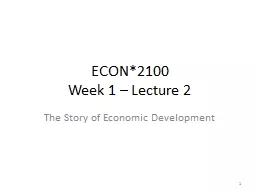

Week 1 Lecture 2 The Story of Economic Development 1 2 Worlds Pre1800 Post1800 2 The Pre1800 World Agriculturebased Subsistence economies High level of equality Low life expectancy ID: 464310
Download Presentation The PPT/PDF document "ECON*2100" is the property of its rightful owner. Permission is granted to download and print the materials on this web site for personal, non-commercial use only, and to display it on your personal computer provided you do not modify the materials and that you retain all copyright notices contained in the materials. By downloading content from our website, you accept the terms of this agreement.
Slide1
ECON*2100Week 1 – Lecture 2
The Story of Economic Development
1Slide2
2 Worlds
Pre-1800Post-1800
2Slide3
The Pre-1800 World
Agriculture-basedSubsistence economiesHigh level of equalityLow life expectancy
3Slide4
The Numbers
World populationAD 0: 231 million
1000: 267 million
1500: 425 million
1820: 1.1 billion
World GDP (1990$)
AD 0:
103 billion
1000: 117 billion1500: 240 billion1820
:
695 billion
4Slide5
Growth began in 1800
Everything began to change in western countriesProportion involved in agriculture began to decline
Economies moved off subsistence
Inequality increased
Life expectancy
grew
http://www.youtube.com/watch?v=BPt8ElTQMIg
5Slide6
Growth begets growth
The Power of CompoundingGrowth rate r
(%) per year
Growth factor (1+
r
)
Suppose
r
= 5% (or, 0.05)Then (1+r) = 1.05Take principle P=$1,000 and let it grow for 1 year
This yields:
1000(1+
r
) = 1000x1.05 = 1050.6Slide7
Growth begets growth
Now suppose we let $1050 grow for a year1050(1+r) = 1050x1.05 = 1102.50
Notice the increment is now larger:
$50.00 earned in first year
$52.50 earned in second year
That’s because we earned interest on the interest
7Slide8
Growth begets growth
We could have solved for the second amount directly:
8Slide9
Growth begets growth
We could have solved for the second amount directly:
More generally, after
T
years we have
Slide10
Growth begets growth
This is an exponential process
Time translates small growth rates into large changes
10
TSlide11
Growth begets growth
Suppose three countries start at $1,000 per capitaEach grows at different rates:Slow : 1%
Medium: 2%
Fast: 3%
After 20 years:
Slow country: $1,220 per capita
Medium country: $1,486 per capita
Fast country: $1,806 per capita
11Slide12
Growth begets growth
Suppose three countries start at $1,000 per capitaEach grows at different rates:Slow : 1%
Medium: 2%
Fast: 3%
After 100 years:
Slow country: $2,705 per capita
Medium country: $7,245 per capita
Fast country: $19,219 per capita
12Slide13
Structural changes
As countries develop, agricultural productivity increasesWorkers leave the Ag sector and enter industry and servicesEmployment shares change over time:
13Slide14
Structural changes
The amount of capital available for each worker goes up
14Slide15
Economic Growth: Summary
Pre-1800 there was little global growthPost-1800 there has been a lot, though not evenly experiencedHuman health, measured as expected lifespan, has increased dramatically
On balance the good aspects outweighed the bad
15Slide16
Economic Growth: Summary
Due to compounding, small changes in annual rate yield large changes in outcomes over timeGrowth involves changes in balance of sectors and techniques within sectors
Income growth requires
increase in capital per worker, which in turn requires
savings and investment
Question: Why
do people in some countries save & invest and others do not?
This often comes down to local institutional differences
16